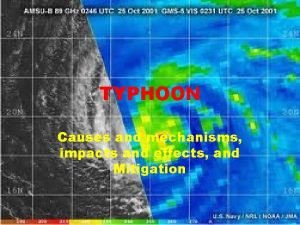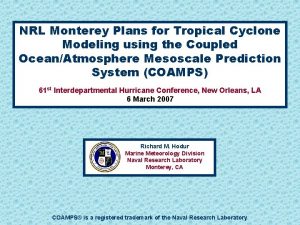Tropical Cyclone Structure2008 TCS08 ONRNRL Funded Projects Project

- Slides: 1

Tropical Cyclone Structure-2008 (TCS-08) ONR/NRL Funded Projects Project Title and Principal Investigator(s) Western North Pacific Tropical Cyclone Formation and Structure Change Patrick A. Harr (paharr@nps. edu) Russell L. Elsberry (elsberry@nps. edu) Naval Postgraduate School Monterey, CA 93943 Scientific Objectives • Collect observations of the Mesoscale Convective Vortices structure and evolution in regions of tropical cyclone (TC) formation • Assess and advance the prediction of TC formation with COAMPS • Observe the external and internal processes leading to TC outer wind structure changes relative to the structure that exists at the time of formation • Observe and compare with COAMPS-predicted latent heating profiles during TC formation. Background • Monsoon depressions are the source of the large TCs in the western North Pacific (e. g. , Harr et al. 1996 Mon. Wea. Rev. ). • Mesoscale convective systems within the monsoon depression determine the location and timing of TC formation • One of the primary mechanisms for changing the outer wind structure of a mature TC is the formation of a secondary eyewall (R. Stenger, Ph. D dissertation, in progress) Field Experiment Requirements • Sample the monsoon depression dynamic and thermodynamic structure leading up to formation time. • Obtain three-dimensional observations by the NRL P-3 ELDORA and Doppler wind lidar of the Mesoscale Convective System that forms near the center of a monsoon depression as merger with the depression circulation occurs • Monitor TC structure to document only small changes until secondary eyewall occurs, and then have NRL P-3 observations to document the role of an inward-spiraling outer rainband to complete the secondary eyewall

